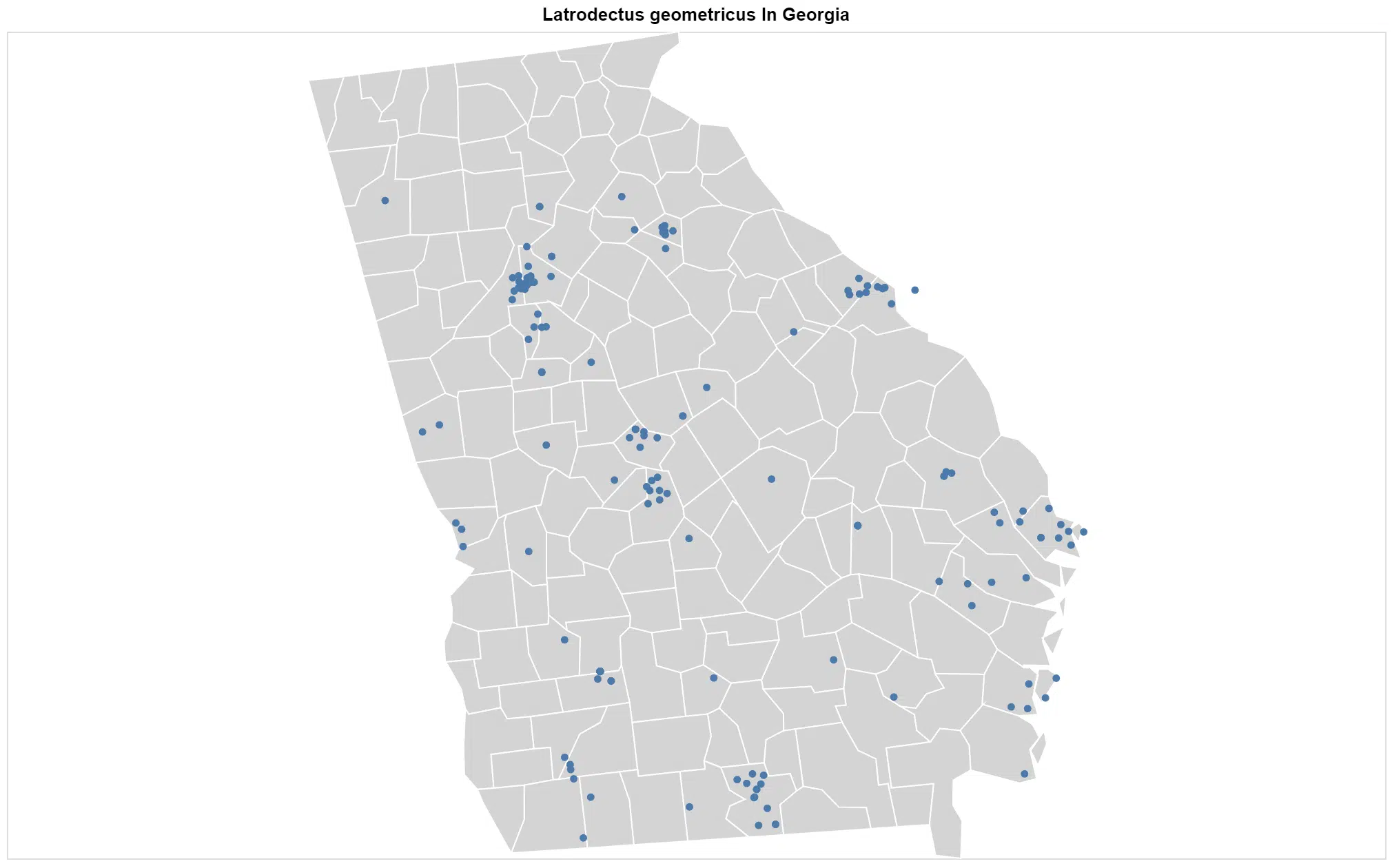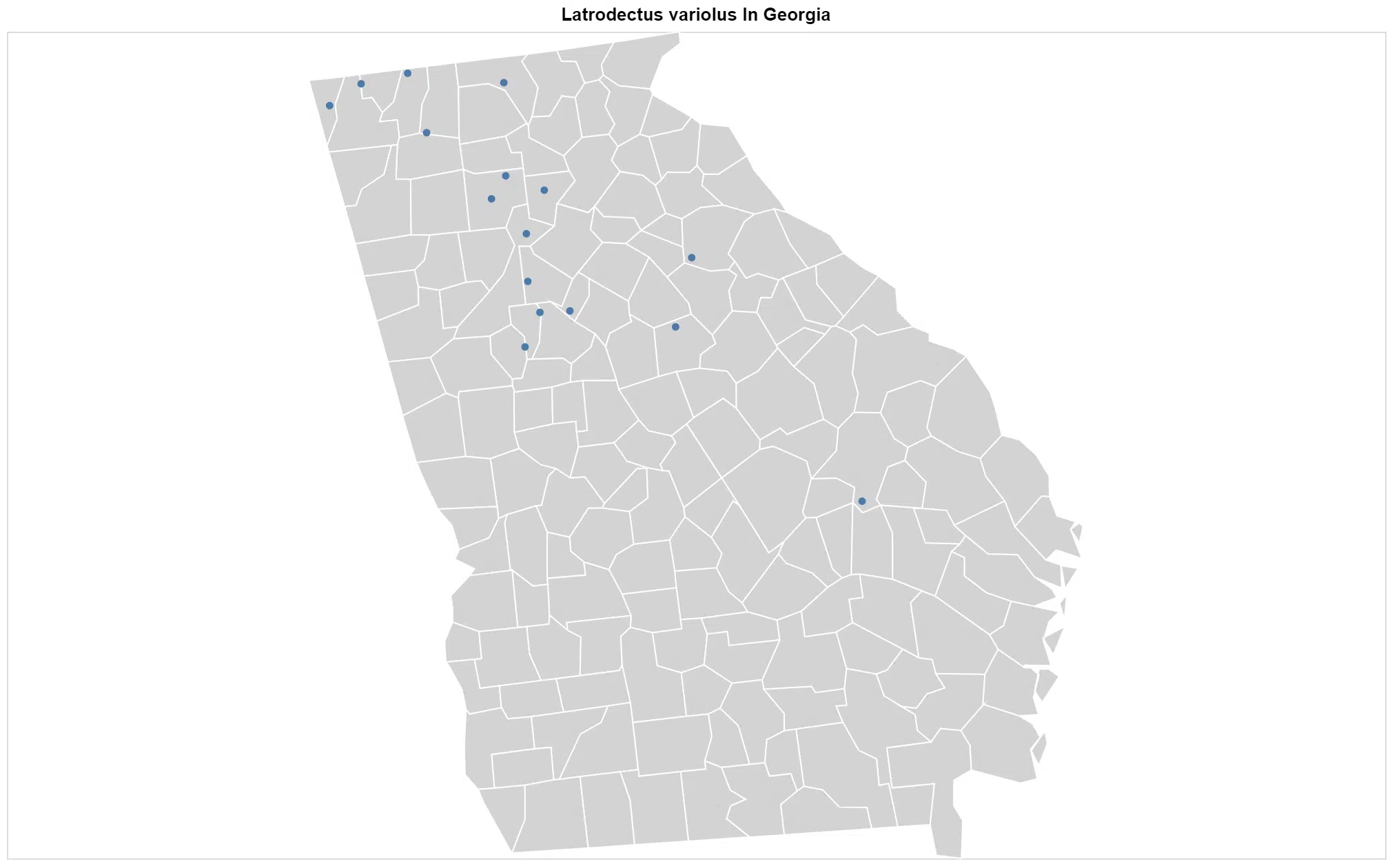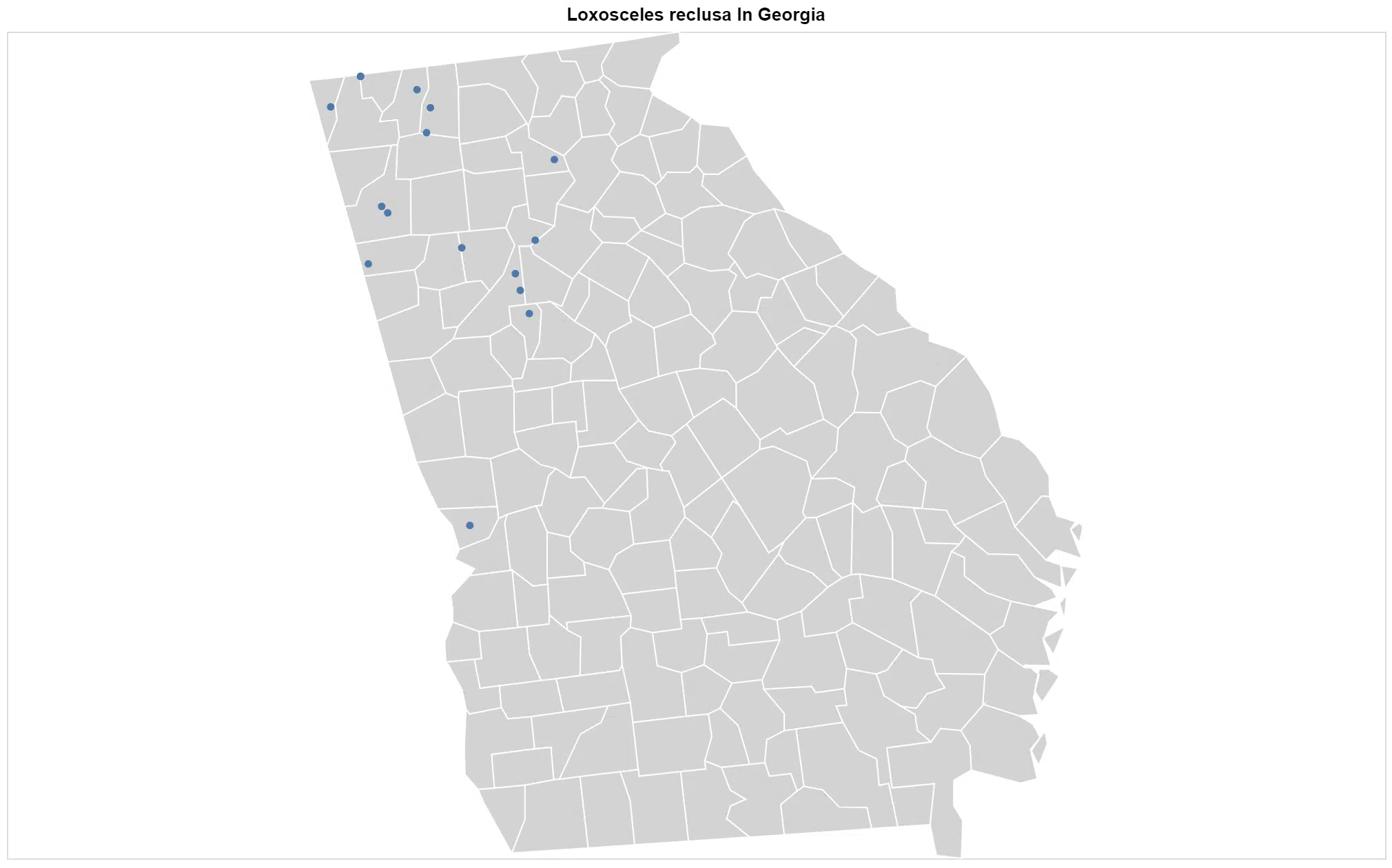Georgia is home to hundreds of spider species, yet only four are considered venomous. Knowing the spiders that are dangerous to humans, along with those that can cause irritation, can help you ensure you get the treatment you need if needed.
There are 6 important facts you should know about the venomous spiders in Georgia.
Venomous Spiders in Georgia
The four venomous spiders in Georgia include:
1. Brown Widow
Scientific name: Latrodectus geometricus.
Common name: brown widow, brown button spider, grey widow, brown black widow, house button spider, geometric button spider.

Brown widow spiders are common in Georgia. Originally they were introduced to the United States in the 1990s in Florida and have moved throughout the country.
Brown widows can be dark brown to black and have a distinct yellow or orange hourglass marking on the underside of their abdomen. They grow to around an inch in body length with eight legs.
They can easily be identified from the black widow with their yellow to orange colored hourglass, rather than red.

Brown widows build their webs in secluded areas, such as closets, garages, empty containers, storage boxes, and buckets.
The good news is that the brown widow is timid and tends to avoid humans where possible.
The other good news is that their bite is not as dangerous as the black widow and doesn’t cause the same symptoms. While their venom is more potent than the black widow, a brown widow doesn’t inject the same volume of neurotoxin when they bite.
Futher Reading:
2. Southern Black Widow

Scientific name: Latrodectus mactans.
Common name: southern black widow, simply black widow, shoe-button spider.
The southern black widow is one of the most famous spiders in the world, known for its venomous toxin. Only the females are dangerous, males and juveniles do not have the same high toxicity.
They are black, shiny, and hairless spiders with juveniles being brown, white, and orange, turning black as they age.
Females are glossy, black with the famous red hourglass pattern on the bottom of their bulb-shaped abdomens. Males are half the size of the female with females often eating the male after mating, which is where they earned the name “widow.”

They try and avoid humans, but tend to spin their webs where they will be visited or disturbed, increasing the risk of an encounter. Their webs are irregular in shape, build near rodent holes, in outbuildings, barns, outhouses, and under stones.
They do not go out of their way to encounter and bite humans, the female will attack and bite if her eggs are threatened. The female southern black widow’s venom is highly poisonous to humans and requires immediate medical attention.
You may not feel the bite at first, until the pain starts, which spreads up the back and into the stomach within twelve hours
3. Northern Black Widow

Scientific name: Latrodectus variolus.
Common name: northern black widow spider, northern widow.
Northern black widows are closely related to the Southern black widow and are shiny and black with red circular dots on the backside. They have a broken red hourglass, which you can see with ease, on their bellies.
There is a distinct separation between the upper and lower part of the hourglass, which sets it apart from the solid hourglass shape of the southern black widow.
Their venom is toxic but not as potent as the southern black widow. Only the female is dangerous, usually when protecting her eggs, while the males remain harmless.
Mortality associated with the northern black widow is one percent with the majority of the fatalities being small children.
If bitten by a northern black widow, you should seek immediate medical attention, as it’s not easy to know what the toxicity of the venom is at the tie of the bite or how you will respond to it.
If the black widow has recently used its venom on an insect, for example, it will have less venom if you are bitten shortly after that.

Northern black widows are often encountered as they create messy webs in woodpiles and undisturbed areas of garages and sheds.
They are not aggressive, but shy and will try and hide, but they do bite if they are disturbed or threatened, usually when you turn over a stone or pick up wood from the woodpiles.
They are active during the night and seldom seen during the day.
Further Reading:
4. Brown Recluse

Scientific name: Loxosceles reclusa.
Common name: brown recluse, fiddleback spider, brown fiddler, violin spider.
The brown recluse spider is also known as the violin spider and its bite may require medical attention. They have necrotic venom.
These spiders can grow to 0.79 inches (20mm) in body length and are light to medium brown in color, though they can vary from black/gray to dark brown and even white.
Their cephalothorax (head space where the legs attach) and abdomen are not always one color. They have a marking on their cephalothorax that looks like a violin with the neck of the violin pointing to the back of the spider.
Unlike the majority of spiders, the brown recluse only has six eyes, which are arranged in pairs.
Their violin marking can vary in visibility, based o the age of the spider. The older the spider, the darker the violin marking tends to be.
They do not have an obvious pattern or coloration on the legs or abdomen and there are no spines on the legs, but the abdomen is covered in short hairs.

These spiders are mostly encountered in northwestern Georgia.
Further Reading:
Other Spiders With Skin Reactions
Some spiders in Georgia are not considered dangerous, but their bite can cause skin irritation. These spiders include:
Northern Yellow Sac Spider

Scientific name: Cheiracanthium mildei.
Common name: Northern yellow sac spider.
The Northern yellow sac spider is a tan to pale green spider with dark brown chelicerae and palpi.
They can grow to around 0.4 inches (10mm) in body length with each leg ending in a double claw and the first pair being up to two times the length of the other legs.
These spiders can give quite a painful bite that starts with an intense stinging, similar to that of a bee sting. This is usually followed by swelling, burning, redness, and itching at the bite site.
Wolf Spiders

Scientific name: Genus Lycosidae.
Common name: wolf spiders.
Georgia is home to more than 25 wolf spider species.
They can grow up to 1.38 inches (35mm) in body length with eight eyes that are arranged in three rows.
Their four larger eyes have reflective tissue, which is reflective when you shine a light beam at them.
They rely on camouflage to protect themselves and are often colored based on their favored habitat.
Some create burrows, while others hide under rocks. Males sometimes make their way into homes searching for a mate during the fall.
Wolf spiders will only bite if provoked. Their necrotic bites result in swelling, pain, rash, and itching at the bite site. Some people develop blisters that are red to purple in color.
What To Do When You See A Spider In Georgia
Most people are not comfortable seeing a spider in their homes. But there are some things you can do, these include:
Carefully Remove It
If you have a spider in your home that you are confident is not dangerous and will not harm you, you can cover it with a container and slide a piece of paper or cardboard underneath.
Turn it over carefully, trapping the spider inside as you remove it outside. You can wear a pair of gardening gloves as a precaution.
Stay Calm
Do not try and kill a spider, as you can anger it if you do miss, which increases the risk of being bitten. Stay calm, use gloves and try and catch the spider safely to return it to the outdoors.
In the Wild
If you come across a spider when out in nature, it’s best to leave it alone and not try and provoke it. Spiders will not try and bite you and often try and avoid humans where possible.
Leaving it alone and allowing it to continue with its route is the best and safest option.
In the Car
Many spiders accidentally make their way into a car and if you are confined, it’s important not to panic.
Wait until it is safe to do so and then pull over, wind down your window, and stop. Winding down the window will cause any wind to keep the spider away from you. If you can use a container to carefully catch and remove it from the vehicle.
What To Do When You Are Bitten
Being bitten by a spider is no laughing matter, often causing pain, swelling, and redness. This is what you need to know if you are bitten.
What to do if bitten by a spider
The good news is that most spider bites are considered minor. You should seek medical attention immediately if:
- You identified the spider as dangerous, such as a brown recluse or black widow
- You are unsure if the spider is dangerous
- You develop pain, abdominal pain and the wound is growing at the bite site
- You are struggling to breathe or swallow
- the bite area has redness or red streaks
Widow bite symptoms
Black widows are easy to identify with their glossy black bodies and red hourglass marking on their bellies. Signs and symptoms of a black widow bite include:
- Pain, swelling, and redness at the bite site
- Abdominal cramping
- Nausea and vomiting
- Tremors and sweating
Recluse spider bite symptoms

The brown recluse can be identified with the violin shape on the back. Signs and symptoms of being bitten by a brown recluse include:
- Mild pain just after the bite
- Chills and fever
- Body aches
- Deep purple to blue area around the bite, which can develop into a red ring
Treatment
If the bite is mild and you know the spider is not venomous, then treatment is relatively easy and can be managed at home. Treatment for non-venomous bites include:
- Cleaning the wound with mild soap and water
- Apply antibiotic cream to the bite site three times a day to avoid infection
- Use a cool compress on the bite for fifteen minutes every hour to reduce swelling and pain
- Elevate the area to reduce swelling
- Take over the counter pain relievers
If the bite is from a venomous spider, you can:
- Clean the wound with soap and water
- Apply a firm bandage to the area
- Do not elevate the area, as this can cause the venom to spread quickly
- Visit the doctor immediately
The doctor may recommend a tetanus injection for your spider bite.

How To Prevent Spiders
Spiders don’t always come inside, most are looking for food or a mate. Males will search for a mate in late summer, so you may see more spiders at this time of year. Some tips to prevent spiders include:
Move Bins
Spiders feed on insects, which makes flies a big attraction. Flies hang around rubbish bins. Move yours as far from the home as possible, keeping them closed. Bins too close to the home can attract spiders, making them come in through open windows and doors.
Turn Off Your Outdoor Lights
Outdoor night lights are an attraction to flying insects, making them a great attraction for spiders, of which most hunt at night. Keeping your night lights off outside will reduce insects and in turn, reduce the number of spiders in the home.
Plant Eucalyptus

Spiders do not enjoy the smell of eucalyptus. Growing this as a houseplant or outside around the perimeter of your home can reduce the risk of spiders moving into your house .This is a natural repellent with a smell you can enjoy.
Try a Cinnamon Candle
Cinnamon is another natural remedy you can try to stop spiders from wanting to be in your home. Burning a cinnamon candle will deter spiders while making your home smell lovely.
Lemon
Another natural way to get rid of spiders is to use lemon peels, rubbing them on the windowsills, door frames, and even bookshelves. Rub the lemon peel against door frames, skirting boards, and cupboard doors, making the area unpleasant for spiders to call home.
Vinegar
Mix vinegar with water in a spray bottle and spray the mixture into crevices and other areas where you tend to find spiders. The vinegar smell does disappear once it dries, but it is enough to send spiders packing.
Clean Up The Home

It’s understandable for things to get busy and you forget to dust or vacuum, but dust, dirt, and clutter are a great attraction for spiders.
Ensure you dust, vacuum, and declutter your home regularly. This will remove any webs that have been created, making it harder for spiders to get comfortable and be undisturbed.
Clean Up the Garden
It’s important to clean up your garden regularly, keep the lawn short and prune your bushes and trees away from windows and doors. Move your firewood away from the home, as spiders love to hide in the crevices between the wood.
Seal Any Cracks
Spiders get into the home through cracks and crevices, which can be around windows, doors, plumbing, and air conditioning vents. Seal up any cracks to reduce the risk of spiders getting inside.
Cover Pet Food
Store pet food in sealed containers and remove food when your pet has finished eating. Try not to feed pets outside if you can. Leftover food attracts flies. Flies attract spiders. Covering and removing leftover food will stop the risk of spiders entering the home.
Wash Your Fruit
While fruit is healthy, it also attracts fruit flies, which then attracts spider. If you buy organic produce, then you may have the odd spider coming into the home.
The best method is to wash the fruit as you bring it into the home, ensuring any insects or spiders are removed.
Summary
Spiders in Georgia do not have to be scary, as long as you know which ones to look out for and where to find them.
Knowing how to treat spider bites and how to prevent spiders can reduce your risk of coming into contact with a venomous spider.
Further Reading: